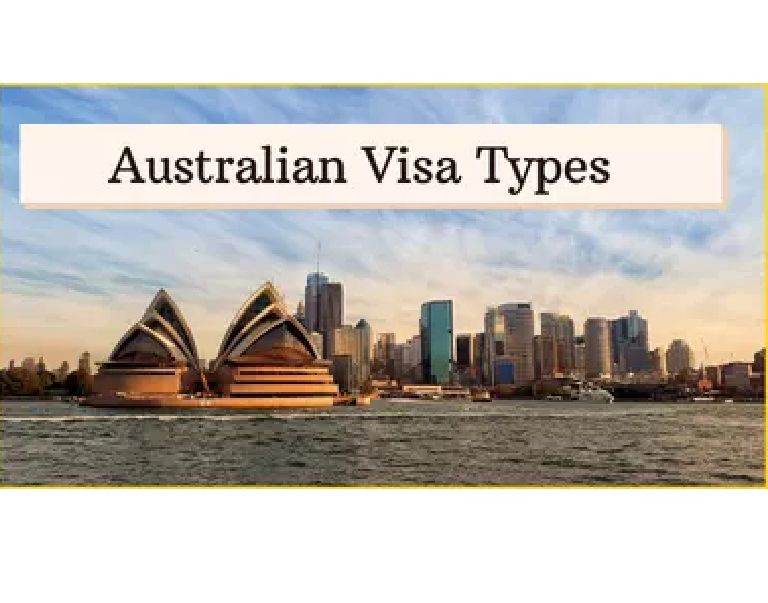Regardless of the reason for their trip, foreign nationals must have a formal authorization in the form of a visa in order to visit or relocate to Australia, sometimes known as the Land Down Under. Immigrants can enter Australia through a variety of routes. Approximately 32,000 family migrants receive jobs each year, according to the bank bazaar, while a growing number of students are moving to Australia to pursue their academic pursuits. Depending on your visit's purpose and specifics, you should apply for one of the categories of Australian visas listed below.
What is an Australian Visa?
Your authority to go to Australia for a set period of time is granted by an Australian visa. Unlike the majority of other countries, Australia doesn't put visa stamps or stickers on your passport. Instead, the immigration officer will check a database on a website to determine if you have a visa when you arrive in Australia. Your visa privileges are electronically saved in this database. Australia's visa policy relates to the conditions that a foreign person desiring to visit the country must satisfy in order to be granted a visa, which serves as a travel authorization to enter and remain in Australia.[1] Additionally, depending on the terms of the visa, the holder may be granted additional rights such as the ability to work, study, and so on.
Different Australian Visa Types
There are eight primary types of visas that you should be aware of depending on the reason for your stay. These eight visa types are only broad classifications. Depending on the nature of visit, you will need to apply for specific visas:
- Business Visa
- Visitor Visa
- Student Visa
- Transit Visa
- Permanent Entry Visa
- Work Visa
- Tourist Visa
- Temporary Entry Visa
Here are some of the work visas that are necessary for skilled immigrants:
1. Work Visa:
The authorization to work A visa is an approval or an official stamp provided to a person who chooses to work abroad. There are several different categories of work permit visas, which may then be divided into temporary and permanent visas. The process for requesting a work permit The type of visa needed depends on the nation, the applicant's nationality, sponsorship, job offer, etc.
2. Permanent Entry Visa:
A PR visa is a kind of authorization that enables you to live and work permanently in the nation with your family. If certain conditions are met, a person with a PR visa may get citizenship.
3. Business Visa:
Travellers who want to undertake business meetings and activities in a nation that do not qualify as labour or a kind of gainful work are issued business visas by the relevant government authorities. Attending meetings, business conferences, and researching company prospects and projects are typical activities carried out while on a business visa.
4. Student Visa:
A student visa is an addition to a government passport that allows international students to enrol in the nation's accredited academic institutions. Any prospective student who wants to pursue higher education abroad must first acquire a student visa from that nation.
5. Temporary Entry Visa:
Conditions that specify what you are permitted to do while you are on a temporary visa, such as a work, student, or visitor visa, are usually attached to them. You could, however, have to submit a fresh visa application in some circumstances.
6. Transit Visa:
A transit visa is a visa that is only good for a brief time. A passenger with an airport transit visa can pass through an airport's international terminal without going on the host nation's soil. Please be aware that not all visitors from other countries must adhere to this rule.
Types of Visa in Australia for Pr
The many forms of Australian visas for permanent residence include:
- A Family-Stream Permanent Visa
- A Business or Investor-Stream Permanent Visa
- A Work-Stream Permanent Visa
The types of Australian visas that need payment are as follows:
1. Bridging Visa in Australia:
You can "bridge" the gap between a prior visa and the visa you are now seeking for in Australia with the use of a bridging visa. A particular class of temporary visa. In Australia, bridging visas come in five different varieties.
- This form of visa, known as a Bridging Visa A (BVA), enables you to remain in Australia beyond the expiration of your existing substantive visa while your new substantive visa application is being processed
- While you wait for your substantive Visa to be issued, you can go abroad and back to Australia on the Bridging Visa B (BVB). Cost of the BVB is around AUD 160 (INR 8,717).
- Non-Australians who desire to apply for a legitimate substantive Visa may do so with the help of the Bridging Visa C (BVC), a temporary visa.
- If your substantive visa has expired, you may use the Bridging Visa D (BVD) to stay in Australia for a little time.
- If your substantive visa has expired or you are awaiting an immigration decision, you may live lawfully in Australia with a bridging visa E (BVE).
2. Skilled Independent Visa Australia:
One of the most common Australian visa types is the skilled visa for Australia, commonly known as Visa category 189. It is designed for invited professionals with certain training and expertise who wish to work in Australia. If you fulfil all the conditions, you will be granted permanent permission to reside, study, and work anywhere in the nation. If the visa is approved, employees will have the same rights as Australian citizens. A skilled visa now costs AUD 4,045 (about INR 2.2 lakhs) in Australia.
3. Dependent Visa for Australia From India:
Your family members with dependent visas for Australia from India may accompany you if you enter Australia on a working visa. Only your spouse or partner and any unmarried children under the age of 18 are eligible to come on a dependent family visa if you are travelling to Australia temporarily for employment. You would have to pay about AUD 4,425 (INR 2.4 lakhs) for this visa.
4. Regional Visa Australia:
The Skilled Visa Australia, commonly known as Visa Subclass 189, is the following type of Australian visa. It is one of the most popular types of Australian visa. It is designed for invited professionals with certain training and expertise who wish to work in Australia. If you fulfil all the conditions, you will be granted permanent permission to reside, study, and work anywhere in the nation. If the visa is approved, employees will have the same rights as Australian citizens. A skilled visa now costs AUD 4,045 (about INR 2.2 lakhs) in Australia.
5. Tr Visa:
The TR Visa Australia, also known as subclass 485, enables you to continue living, studying, and working in Australia after you have completed your degree programme there. The two streams that make up the visa are the Graduate Work Stream and the Post Study Work Stream. The Graduate Work Stream declares that you can live and work in Australia if you have just graduated from a course related to your occupation where there is a talent deficit. The Post-Study Work Stream states that if you have recently graduated from a course related to your occupation where there is a skill need, you are eligible to apply. A TR Visa application in Australia costs AUD 1,500 (about INR 81,723).
6. 186 Visa Australia:
Another visa among the Australian visa types is Visa 186 Australia. It is intended to make it possible for skilled professionals to live and work permanently in Australia. Even though it is harder to get than other visas since it is nominated, permanent residency is valuable. Direct Entry, Labour Agreement Stream, and Temporary Residence Transition Stream are the three visa streams offered by 186 Visa Australia. You would have to pay about AUD 4,045 (INR 2.2 lakhs) for this visa.
Australian Visa Requirements
There is a point system that is established in Australia if you want to apply for an Australian permanent residence visa. A minimum of 65 points must be beneath the Point's grid.
| Category | Maximum Points |
|
|
|
|
|
|
|
|
|
|
|
|
Australian Visa Application
The procedures for requesting any type of Australian visa are listed here.
-
Step 1:
Determine the kind of Work Visa you are qualified for..
-
Step 2:
Verify that you are eligible for a Working Visa by meeting the Skillselect criteria.
-
Step 3:
Before applying for the Visa you can apply for, make sure your company completes an online nomination/sponsorship form.
-
Step 4:
Complete the visa category application form.
-
Step 5:
Submit your application along with any pertinent information and supporting documentation.
-
Step 6:
Pay your application money in order to process your visa in step six.
How Long is the Processing Time for Australia?
Depending on the kind of visa, processing times for Australian visas might differ. The majority of visa requests submitted through the tourist stream are typically processed in a matter of weeks, at most four months; but, if all goes according to plan, it may just take a few days. Applications for long-term visas may take several months to more than a year to process, depending on the kind of visa.





.jpg-48800.jpg)

